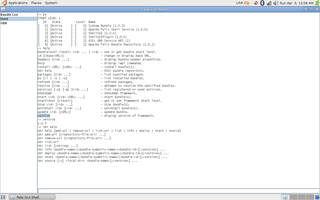
OSGi is an open specification and open source project under the Eclipse Foundation. It is a continuation of the work done by the OSGi Alliance, which was an open standards organization for computer software founded in March 1999. The foundation originally specified and maintained the OSGi standard. The alliance transferred its work to the Eclipse Foundation at the end of 2020. The OSGi specification describes a modular system and a service platform for the Java programming language that implements a complete and dynamic component model, something that does not exist in standalone Java or VM environments. It has a service-oriented architecture based on micro services each implemented as an extended Java class file archive.
ZIP is an archive file format that supports lossless data compression. A ZIP file may contain one or more files or directories that may have been compressed. The ZIP file format permits a number of compression algorithms, though DEFLATE is the most common. This format was originally created in 1989 and was first implemented in PKWARE, Inc.'s PKZIP utility, as a replacement for the previous ARC compression format by Thom Henderson. The ZIP format was then quickly supported by many software utilities other than PKZIP. Microsoft has included built-in ZIP support in versions of Microsoft Windows since 1998 via the "Plus! 98" addon for Windows 98. Native support was added as of the year 2000 in Windows ME. Apple has included built-in ZIP support in Mac OS X 10.3 and later. Most free operating systems have built in support for ZIP in similar manners to Windows and Mac OS X.

Eclipse is an integrated development environment (IDE) used in computer programming. It contains a base workspace and an extensible plug-in system for customizing the environment. It is the second-most-popular IDE for Java development, and, until 2016, was the most popular. Eclipse is written mostly in Java and its primary use is for developing Java applications, but it may also be used to develop applications in other programming languages via plug-ins, including Ada, ABAP, C, C++, C#, Clojure, COBOL, D, Erlang, Fortran, Groovy, Haskell, JavaScript, Julia, Lasso, Lua, NATURAL, Perl, PHP, Prolog, Python, R, Ruby, Rust, Scala, and Scheme. It can also be used to develop documents with LaTeX and packages for the software Mathematica. Development environments include the Eclipse Java development tools (JDT) for Java and Scala, Eclipse CDT for C/C++, and Eclipse PDT for PHP, among others.

Apache Ant is a software tool for automating software build processes which originated from the Apache Tomcat project in early 2000 as a replacement for the Make build tool of Unix. It is similar to Make, but is implemented using the Java language and requires the Java platform. Unlike Make, which uses the Makefile format, Ant uses XML to describe the code build process and its dependencies.
Maven is a build automation tool used primarily for Java projects. Maven can also be used to build and manage projects written in C#, Ruby, Scala, and other languages. The Maven project is hosted by the Apache Software Foundation, where it was formerly part of the Jakarta Project.
In computing, an archive file is a computer file that is composed of one or more files along with metadata. Archive files are used to collect multiple data files together into a single file for easier portability and storage, or simply to compress files to use less storage space. Archive files often store directory structures, error detection and correction information, arbitrary comments, and sometimes use built-in encryption.
EAR is a file format used by Jakarta EE for packaging one or more modules into a single archive so that the deployment of the various modules onto an application server happens simultaneously and coherently. It also contains XML files called deployment descriptors which describe how to deploy the modules.
In software engineering, a WAR file is a file used to distribute a collection of JAR-files, JavaServer Pages, Java Servlets, Java classes, XML files, tag libraries, static web pages and other resources that together constitute a web application.
The Java Class Loader is a part of the Java Runtime Environment that dynamically loads Java classes into the Java Virtual Machine. Usually classes are only loaded on demand. The Java run time system does not need to know about files and file systems as this is delegated to the class loader.

Apache Felix is an open source implementation of the OSGi Core Release 6 framework specification. The initial codebase was donated from the Oscar project at ObjectWeb. The developers worked on Felix for a full year and have made various improvements while retaining the original footprint and performance. On June 21, 2007, the project graduated from incubation as a top level project and is considered the smallest size software at Apache Software Foundation.
The Java Platform Module System specifies a distribution format for collections of Java code and associated resources. It also specifies a repository for storing these collections, or modules, and identifies how they can be discovered, loaded and checked for integrity. It includes features such as namespaces with the aim of fixing some of the shortcomings in the existing JAR format, especially the JAR Hell, which can lead to issues such as classpath and class loading problems.
A manifest file in computing is a file containing metadata for a group of accompanying files that are part of a set or coherent unit. For example, the files of a computer program may have a manifest describing the name, version number, license and the constituent files of the program.
Action Message Format (AMF) is a binary format used to serialize object graphs such as ActionScript objects and XML, or send messages between an Adobe Flash client and a remote service, usually a Flash Media Server or third party alternatives. The Actionscript 3 language provides classes for encoding and decoding from the AMF format.
The Android Package with the file extension apk is the file format used by the Android operating system, and a number of other Android-based operating systems for distribution and installation of mobile apps, mobile games and middleware. A file using this format can be built from source code written in either Java or Kotlin.
Apache Click is a page and component oriented web application framework for the Java language and is built on top of the Java Servlet API.
The Java Development Kit (JDK) is a distribution of Java Technology by Oracle Corporation. It implements the Java Language Specification (JLS) and the Java Virtual Machine Specification (JVMS) and provides the Standard Edition (SE) of the Java Application Programming Interface (API). It is derivative of the community driven OpenJDK which Oracle stewards. It provides software for working with Java applications. Examples of included software are the virtual machine, a compiler, performance monitoring tools, a debugger, and other utilities that Oracle considers useful for a Java programmer.
Virgo is an open source, OSGi-based, Java application server. Virgo supports the deployment of OSGi bundles and unmodified Java web applications as well as OSGi-influenced Shared Libraries WARs and Shared Services WARs.
This article compares the application programming interfaces (APIs) and virtual machines (VMs) of the programming language Java and operating system Android.




